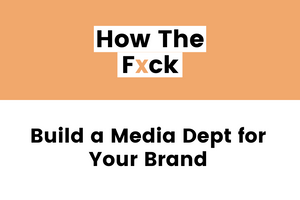Dave Gerhardt posted this almost exactly a year ago (original credit: Gary Vaynerchuk).

But he never talked much about how to do it. Or what he meant for that matter.
What I think he means, really, is that modern marketing teams need all the skillsets of a media company:
• Videomakers
• Editors
• Podcasters
• Graphic designers
• Content writers
• Copywriters
And your team needs these skills because to capture attention you need to create content that is actually consumed—the stuff that adds more value to the consumer than it takes, like a newspaper, Instagram influencer or podcaster would. (Related: How to start a podcast even if you're a nobody)
The difference between a company with content and a newspaper or podcaster? For newspapers and podcasts, the content is the product. It must be high-quality, invested in content that serves the reader. It can't be "all about me" content that most brands put out.
I generally consider this ‘not about us’ part of marketing: brand building.
Les Binet and Peter Field, the famed advertising researchers, make a distinction between the short (activation) and long (brand building) of revenue generation.
They found that over the long-term, a company gets more sales and market share if they focus on long-term brand plays.

This is partly why building a media company in your niche is so powerful—because you will win on brand in the long-term, and ‘media’ will be your route to growing a great brand. Note: This graph supports brand building as a concept, but also shows that sales activation is a critical and valuable part of a companies continued growth. Having one without the other would also leave a lot of growth on the table.
It feels like a hard sell because we live in a world of short-termism. But building a brand has an impact:
• It creates affinity for you, your team, your company.
• It allows you to educate the marketing about your strategic narrative—nothing beats changing the mind of the market in a way that favours your product.
• It creates secondhand product awareness.
• It shortens your sales cycle, improves ad efficiency, and wins mental availability.
And while it won’t deliver results right now (in the same way sales or product-focused digital ads do) if you don’t do it you will be forever dependent on short-term uplifts.
Brand building examples
Some companies go ALL OUT on media as their route to brand.
Red Bull is a classic example—an energy drink company that I’ve never seen talk about energy drinks online.
Their social media channels are all about extreme sports—they sponsor events and channel professional athletes, they produce high-quality videos, clips, and documentaries about extreme sports.
Tesla has done the same. Elon Musk, the founder, hosted Saturday Night Live this week and not once did he mention his company, Tesla.
It doesn’t matter, we all know about Tesla thanks to his insane PR prowess. Even if he doesn’t talk about Tesla, every news story about him will mention it.
I saw a TikTok channel recently that just posted videos of pets getting their hair washed and cut…millions of likes per video. The owners of the TikTok sold dog shampoo.
Yes, it’s easier if you sell a product that has anything to do with puppies.
You may have noticed that all these companies are in the B2C space.
If you’re in B2B, why can’t you do something similar? After all, you’re still human when you’re at work.
For brand marketers, being in B2B shouldn’t stop you from being interesting, unique and bold.
GaryVee, Chris Walker, Neil Patel, Rand Fishkin, Casey Graham.
All B2B business leaders. All have huge personal brands built around sharing value through media.
Slack and Gong are still having fun with it.

B2B brands these days need to invest much more in media.
You need to find your puppies (the overlap between things people love and your industry—if you skipped ahead, go back).

If you make cool, fun, useful content for your target audience, then you’ll quickly build a following. (P.s. the B2B world tends to focus on the safe bet: useful. But, the gap in the market is the fun stuff. It just feels hard to find the intersection of fun and most B2B companies right now.)
The following you build is a channel you can use to build affinity, educate about your product, and be top of mind when that individual needs you.
To build that following you need think more like a creative media team.
☮️ If you don’t already, subscribe for more like this right here.


